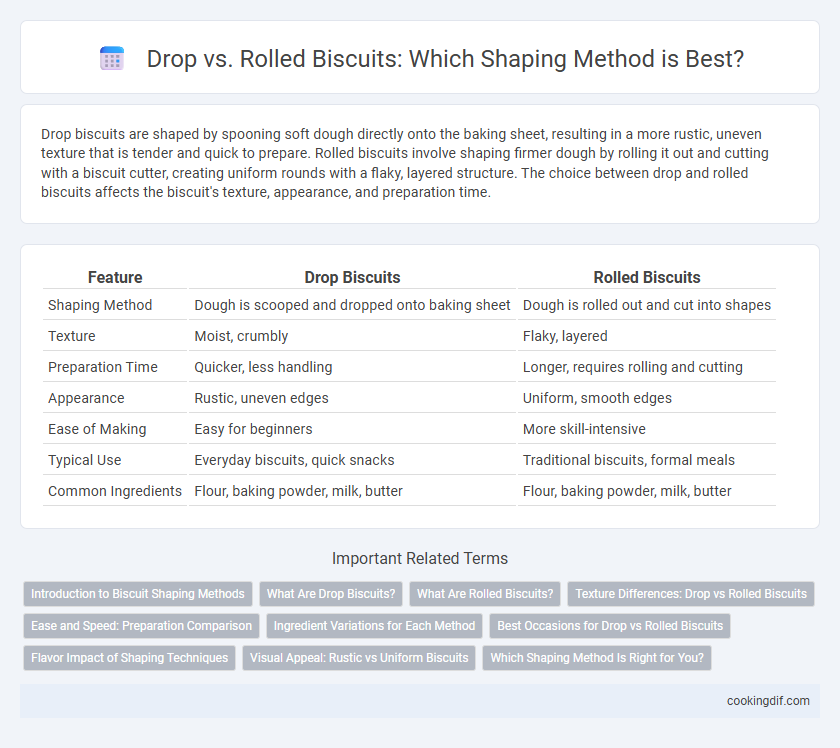Drop biscuits are shaped by spooning soft dough directly onto the baking sheet, resulting in a more rustic, uneven texture that is tender and quick to prepare. Rolled biscuits involve shaping firmer dough by rolling it out and cutting with a biscuit cutter, creating uniform rounds with a flaky, layered structure. The choice between drop and rolled biscuits affects the biscuit's texture, appearance, and preparation time.
Table of Comparison
| Feature | Drop Biscuits | Rolled Biscuits |
|---|---|---|
| Shaping Method | Dough is scooped and dropped onto baking sheet | Dough is rolled out and cut into shapes |
| Texture | Moist, crumbly | Flaky, layered |
| Preparation Time | Quicker, less handling | Longer, requires rolling and cutting |
| Appearance | Rustic, uneven edges | Uniform, smooth edges |
| Ease of Making | Easy for beginners | More skill-intensive |
| Typical Use | Everyday biscuits, quick snacks | Traditional biscuits, formal meals |
| Common Ingredients | Flour, baking powder, milk, butter | Flour, baking powder, milk, butter |
Introduction to Biscuit Shaping Methods
Drop biscuits, made by spooning soft dough directly onto the baking sheet, create a rustic texture with uneven edges, ideal for quick preparation without the need for rolling. Rolled biscuits require flattening the dough with a rolling pin, producing uniform thickness and clean edges, resulting in a fluffier, more consistent rise during baking. Each method influences the biscuit's crumb structure and tenderness, catering to different preferences and baking styles.
What Are Drop Biscuits?
Drop biscuits are soft, moist, and thicker than rolled biscuits, made by dropping spoonfuls of batter directly onto a baking sheet instead of rolling and cutting the dough. This shaping method results in a more rustic texture with a tender crumb and less flaky layers compared to rolled biscuits. Drop biscuits are ideal for quick preparation and produce a biscuit with a denser, cake-like interior suitable for hearty breakfast dishes or savory sides.
What Are Rolled Biscuits?
Rolled biscuits are a traditional shaping method where the dough is gently rolled out on a floured surface to an even thickness and then cut into shapes using a biscuit cutter or glass. This technique creates uniform, tender layers that bake into flaky, light biscuits with a soft interior. In contrast to drop biscuits, rolled biscuits require more handling but produce a classic texture prized in Southern-style baking.
Texture Differences: Drop vs Rolled Biscuits
Drop biscuits have a softer, more crumbly texture due to their higher moisture content and less handling, resulting in a tender crumb. Rolled biscuits feature a flakier, layered texture achieved by rolling and folding the dough, which develops distinct layers and a slightly denser bite. The shaping method directly influences the biscuit's tenderness, flakiness, and overall mouthfeel.
Ease and Speed: Preparation Comparison
Drop biscuits require minimal handling and are ideal for quick preparation, as the batter is simply scooped onto the baking sheet, reducing shaping time and effort. Rolled biscuits involve rolling out dough and cutting into shapes, which takes more skill and time but provides uniform thickness and appearance. For fast, easy biscuit making, drop biscuits offer a superior time-saving advantage without compromising taste.
Ingredient Variations for Each Method
Drop biscuits use a wetter dough with higher liquid content, often incorporating buttermilk or cream to create a soft, tender texture that requires minimal handling. Rolled biscuits have a stiffer dough with more flour and less liquid, allowing precise shaping and layers, with ingredients like shortening or butter cut into the flour for flakiness. Ingredient ratios differ to suit each method's handling requirements and desired crumb structure, influencing moisture levels and fat distribution.
Best Occasions for Drop vs Rolled Biscuits
Drop biscuits, characterized by their loose dough shape, are ideal for casual meals, picnics, and potlucks where ease and speed are essential. Rolled biscuits, known for their uniform thickness and classic flaky layers, excel at formal dinners, brunches, and holiday feasts requiring a polished presentation. Choosing between drop and rolled biscuits depends on the event's formality and the preparation time available.
Flavor Impact of Shaping Techniques
Drop biscuits, shaped by spooning thick batter directly onto a baking sheet, yield a moist and tender crumb with irregular, rustic textures that enhance flavor absorption. Rolled biscuits, cut from stiff dough rolled out evenly, develop a flaky, layered structure that creates distinct buttery pockets and a more pronounced buttery taste. The shaping method directly influences moisture retention and crumb consistency, impacting the biscuit's overall flavor profile and mouthfeel.
Visual Appeal: Rustic vs Uniform Biscuits
Drop biscuits have a rustic visual appeal with their uneven, rough edges and irregular shapes, highlighting a homemade charm. Rolled biscuits present a uniform, consistent appearance with smooth edges and even thickness, emphasizing precision and refinement. Choosing between drop and rolled shaping methods depends on whether a natural, artisanal look or a polished, classic biscuit presentation is desired.
Which Shaping Method Is Right for You?
Drop biscuits use a spoon or scoop to portion dough onto a baking sheet, resulting in a softer, rustic texture ideal for quick preparation. Rolled biscuits require rolling out the dough and cutting it into rounds, creating flaky layers and a more uniform shape perfect for traditional presentations. Choose drop biscuits for ease and speed, while rolled biscuits suit those seeking a classic, flaky biscuit experience.
Drop vs Rolled for shaping method Infographic

 cookingdif.com
cookingdif.com